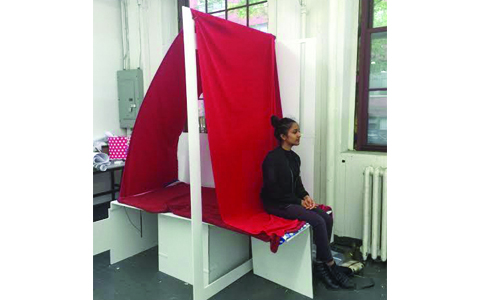ISB educated interior designer develops refugee shelter in NY
Manama : Indian School Bahrain educated Sanjana Paramhans’ shelter can be built in an hour and can house refugees for months.
The New York-based Indian interior designer Sanjana Paramhans, who completed her basic education from Indian School Bahrain and graduated from the Pratt Institute in New York, has a Bachelor of Fine Arts degree in interior designing. She made the president’s list honour roll twice and the dean’s list thrice. She created the prototype while working on her undergrad thesis last year.
The shelter is made from fiberglass-reinforced gypsum, which makes it extremely light, while not compromising its structural stability. It can also be easily packaged and shipped.
Paramhans mentioned that her design offers “a sanctuary for those who are temporarily displaced.”
“It is an emergency shelter, for refugees to settle in before the legalities take place,” she told DT.
“Although it is intended to last a few days, sometimes the refugee settlement processes can take months, leaving the refugees in temporary dwellings. My idea was to design a shelter that will provide comfort to refugees while they wait for permanent resettlement.”
The shelter has a bed which can also be converted into a chair and a storage space.
“To enforce permanency, I tried to pay attention to privacy, not only for the inhabitants, but also their goods,” said the interior designer, who now works for Smallbone of Devizes, a UK-based firm.
Paramhans said she was “deeply affected by the situation and conditions of the refugees” and “really wanted to do something” to help them out.
“I first thought of donating money, but I felt like I wanted to do more than that,” she said. “I wanted to use my knowledge and skills to design a solution that would be more permanent than simply donating money.”
Paramhans said the emergency shelter can be easily built by two people without using any electrical hardware.
“While thinking of the concept I tried to keep in mind what would be most important for the refugees, which would be the sense of permanency in a temporary situation,” she said. “I also thought it was important to create a system that would be flexible for use, and to create a sense of community.” When fully operational, the module looks like a house with an incorporated roof. It was designed in such a way to accommodate individuals to a large family.
Paramhans told that she is trying to find the right platform to make it available for refugees worldwide. “I would love to collaborate with an NGO and push this design forward, and try to reach it out to as many people in need as possible,” she said.
“I think what is so great about this initiative is that Sanjana has shown us that innovation and design can be used to solve some of the most trivial as well as life and death problems of the world,” Deborah Scheniderman, a professor of Interior Design in the School of Design at Pratt Institute and Paramhans’ thesis adviser, said, “Design stimulates people to behave a function a certain way — it can condition and control their actions and reactions. Design is not just pretty lights and wallpapers, it is an enabler of social change.”
Enabling social change is also what Paramhans wants to do long-term.
She said, “In the future, I see myself working as a social designer, using design and design thinking as a tool to deal with economic and social challenges in the world.”
Related Posts


